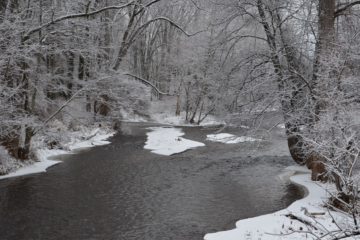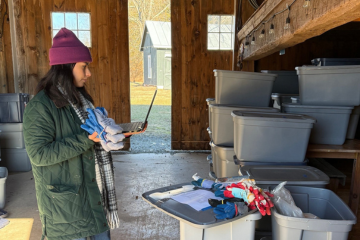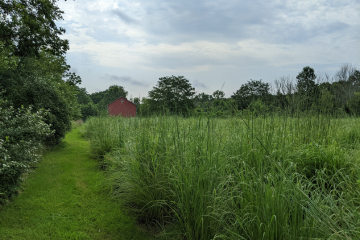While hiking or travelling in winter throughout our upper Raritan River watershed, have you ever noticed leaves stubbornly clinging to the branches of certain trees, fluttering in the breeze but not falling to the ground? It’s likely that the trees you’re seeing are American beeches, one of the loveliest of our native species – and my personal favorite!
In winter many beeches, especially younger trees, hold tightly onto their dead leaves. Their warm, bronze color add a subtle beauty to the bare winter landscape. Only in the early days of spring will new buds push off last season’s leaves. Why do beech trees do this? One theory holds that it’s an evolutionary adaptation to discourage large browsing mammals like deer from munching on the tender new buds.
Beech trees host important insects and provide shelter and homes for cavity-nesting birds like black-capped chickadees and wood ducks. Their nuts are a valuable resource for local wildlife. Each autumn, mature trees drop nuts encased in a distinctive spiky covering that eventually splits open. Beechnuts are exceptionally high in protein and fats, feeding wild turkeys, chipmunks, bears, squirrels, deer, and opossum.
Growing up in a home surrounded by mature forests I was most in love with the magnificent beech trees that dotted the Bedminster hillsides and lined the brooks that traversed my childhood playground. Like others that had carved their initials and declarations of love, I naively left my monogram on the smooth, gray bark of my favorite specimens.
Unfortunately, my beloved tree is facing a new peril. This past summer, I noticed that the leaves of beech trees along the Raritan River and local tributary streams were darkening and curling. What was happening? A little research told the story: Beech Leaf Disease (BLD).
Discovered in Ohio in 2012 and first confirmed in New Jersey in 2020, BLD is a blight caused by a nematode, a tiny worm that feeds on plant cells, bacteria, fungi, and other microscopic creatures.
Researchers are scrambling to find a cure. I reached out to our local foresters at Gracie and Harrigan who shared studies by Penn State – Beech Leaf Disease. Suggested treatments exist for beech trees in your yard; however, large-scale treatment in a forest setting is not feasible. As of now, the prognosis for beech trees in the wild isn’t good.
Let’s hope that the progress of BLD can be slowed or stopped, because the loss of these magnificent trees would reduce tree diversity in New Jersey forests, impacting wildlife and humans. Healthy forests are a major contributor to the protection of water quality here in the Upper Raritan watershed and beyond.
For an organization that works every day to protect clean water and healthy lands, BLD is unwelcome news. Raritan Headwaters will, of course, stay tuned and report on the scientific community’s progress. In the meantime, we encourage planting a diversity of native trees in your landscape. By increasing tree diversity, the transmission of diseases and pests among trees can be avoided if not eliminated.
This piece is published in the Black River Journal’s 2024 Holiday Issue available online at www.blackriverjournal.com or found at local establishments in print.



